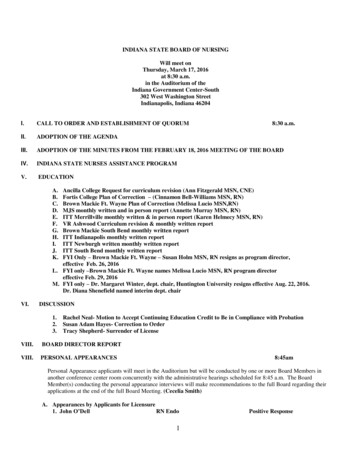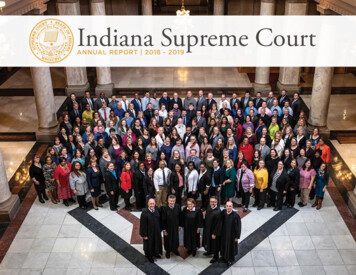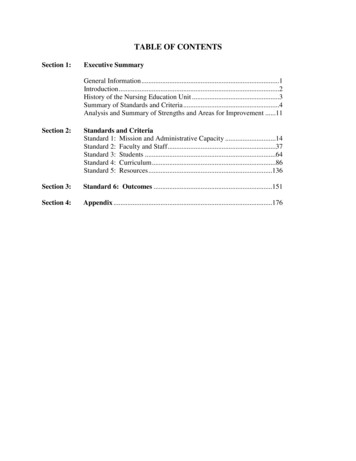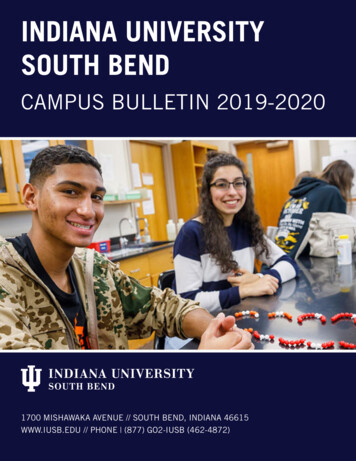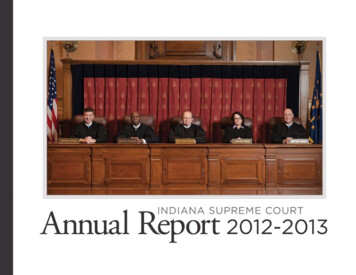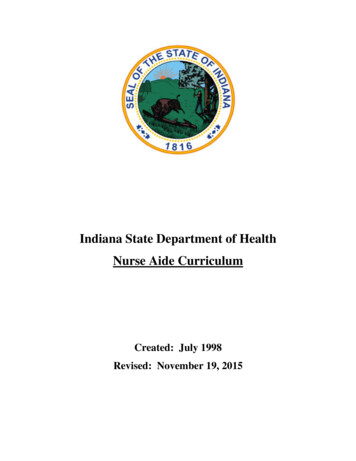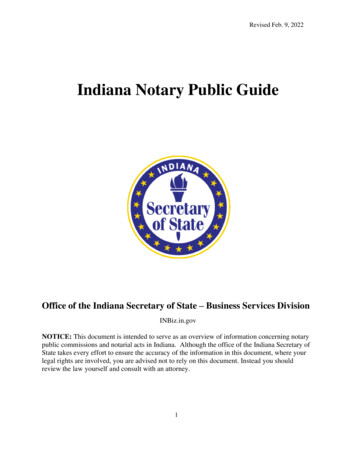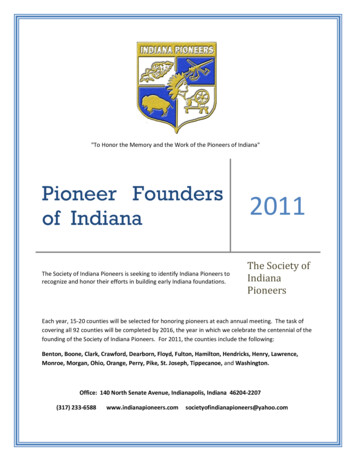
Transcription
"To Honor the Memory and the Work of the Pioneers of Indiana"Pioneer Foundersof IndianaThe Society of Indiana Pioneers is seeking to identify Indiana Pioneers torecognize and honor their efforts in building early Indiana foundations.2011The Society ofIndianaPioneersEach year, 15-20 counties will be selected for honoring pioneers at each annual meeting. The task ofcovering all 92 counties will be completed by 2016, the year in which we celebrate the centennial of thefounding of the Society of Indiana Pioneers. For 2011, the counties include the following:Benton, Boone, Clark, Crawford, Dearborn, Floyd, Fulton, Hamilton, Hendricks, Henry, Lawrence,Monroe, Morgan, Ohio, Orange, Perry, Pike, St. Joseph, Tippecanoe, and Washington.Office: 140 North Senate Avenue, Indianapolis, Indiana 46204-2207(317) neers@yahoo.com
The Pioneer Founders of Indiana ProjectIn 2010, the Society of Indiana Pioneers embarked on a project torecognize Indiana Pioneer Settlers who helped to lay the firstfoundations of civilized life in Indiana. The Society plans to recognizefounding settlers in each county. The project's completion is designedto coincide with Indiana’s 200th anniversary of statehood in 2016.Each year, nominations are solicited from a different group ofcounties so that all nominations will have been received from eachcounty by the time we reach the bicentennial celebration. Allnominations of qualified individuals will be accepted. The only criterionis that they must have settled in Indiana before the cut-off dates alreadyestablished for individuals to be recognized as Pioneers.Anyone may make a nomination. All nominations are acceptedregardless of which county it comes from. Nominations may becontributed even if we have already solicited nominations for the countyof the settler’s residence.Nominations do not need to be limited to leaders or well-knownindividuals. Housewives and farmers are just as important as governorsand senators.With the Founding Settlers project, the Indiana Society of Pioneershopes to illuminate the contributions of many who helped carve our stateout of the wilderness and to give a voice to those who have fallen silent,but who did so much to open our state to settlement.Robert W. DoraCommittee Chairman
County2011 Pioneer Founders of IndianaBentonMilton JenningsGeorge JenningsBooneAbraham Utter Sr.ClarkSamuel SpearRobert BiggsCrawfordPeter RothrockSolomon RothrockDearbornCaptain Samuel Colville Vance Willard WhippleFloydAsa SmithFultonEbenezer WardHamiltonGeorge Boxley Peter /Marie/ Simon Achenbach John Harvey Amos CarsonJoseph and Lousada (Bryant)Lacey (Lacy)HendricksAlexander McCalment Barthomew RamseyHenryThomas R. StanfordAllen/Alan ShepherdLawrenceJohn P. DarrMonroeAndrew WylieMorganGeorge MatthewsOhioEnoch DrakeOrangeHenry ShirleyPerryReuben BatesPikeKeziah Ball GraySt. JosephFather Benjamin Marie PetitTippecanoeAlbert S. WhiteAdam RiceHenry T. JenningsLarkin Howard John GibsonJames Butler MooreJames MatlockRobert "Blackhawk" StewartJohn EwbankPeter HuffmanNathan/Oliver Holt WorleyJoseph/ Mary Worley/ Samuel MontgomeryGeorge FultzWalter CourllJohn FadelyAsa Warnock & Malinda Windsor WarnockRobert Holiday CooperWilliam Monroe MacyJoshua, Elizabeth and William CarterHarbard P. DeBrulerJacob CoxGeorge Winter John PurdueWashingtonAmbrose GarriottCalleralzamon Rubison (aka Calza) Robert MitchellSarah Houston Tucker (Sally) John Tucker Joseph Reyman Henry Wyman Sarah (Sally) RobertsonAndrew and Cela "Sarah" Wright Ratts Lewis Martin
Additional 2010NominationsCarrollSamuel and Thomas RossJames Ralston BlanchardVine HoltEnoch Rinehart Erastus W. HubbardScottJohn KimberlinWilliam Hayden EnglishWayneWilliam and Mary BeesenKnoxWilliam Henry HarrisonHarrisonJohn and Sarah (Litsey)DavisMary Nance ShieldsJacob Lamb Kintner SrWilliam MarshElizabeth MarshWilliam Thompson ShieldsAgnas Creitz KintnerCatherine Lamb KintnerJohn A. BestSusannah Lopp BestJesse C. MarshSarah Jane Leslie MarshCaroline Jameson ShieldsJohn MauckFrederick MauckHenry FaithMatilda Ann Strange FaithJacob L. Kintner Jr.Patrick Henry ShieldsAnna Catherine Hamm LoppJoseph Livingston MarshJoesph/ Lousada LacyElizabeth Graham Shields KintnerMary Jones NanceJohn LoppElisha Gale EnglishIsaac/Sarah/Abraham OrbaughClement NanceDavid R. HarleyMargaret Holliday MarshJesse ShieldsJohn JamesonHarrison W. SteepletonThomas P. FaithCatherine Fox ShieldsMary Jane JamesonElizabeth Mauck Steepleton
2010 CountiesAllenCassCarrollClinton2011 Counties2012 HancockHowardFloydHuntingtonLa arkeMontgomery renVigoWaynePikeSt. JosephWellsTippecanoeWashingtonWhitley
THE SOCIETY OF INDIANA PIONEERSBenton CountyMilton JenningsDate and Place of Birth: December 1810---Benton County (Territory), IndianaDate and Place of Death: January 5, 1847---Benton County, IndianaMilton Jennings, son of Henry Jennings, was the first treasurer of Benton County. At the time of theorganization of Benton County in 1840 he was in his thirty-first year. He was already considered a reliablefree holder and a man of means and was appointed treasurer by the Board of County Commissioners, anoffice to which he was thereafter annually appointed until his death. Milton and the Jennings family wereamong the original settlers of Benton County. Land purchased by Henry Jennings, Milton's father, dates toOctober 23, 1832, and was south of the railroad bridge across Big Pine Creek east of the present village ofTempleton. Milton married Maria Finch, a sister of George Finch, of Pine Township, who was broughtfrom Pickaway County, Ohio, by their uncle, Basis Justus. They had two children, Melissa, afterwards thewife of Colonel William J Templeton, and George H. Jennings, afterwards one of the most distinguishedstockmen and landholders of this county. Milton died at the age of 36 and is buried in the old JenningsGriffin Cemetery on the east bank of Big Pine Creek.Contributor:--Mary Jennings RemsterHenry T. JenningsDate and Place of Birth: 1774-1775---OhioDate and Place of Death: June 1839---Tippecanoe County, IndianaHenry T. Jennings, son of David and Sarah Cushman Jennings, born in 1774 or 1775 in Ohio. Henryserved in the War of 1812. His first marriage was to Sarah Smith, May 12, 1799. She died in 1824 inDayton, Ohio. Henry and Sarah had eleven children, which included Milton Jennings. His 2nd marriagewas to Christina Titus in 1827. Henry and Christina had six children. He purchased land in Benton County
on October 23, 1832, entered as the west half of the southeast quarter of section 22-24-7, which is justsouth of the railroad bridge across Big Pine Creek east of Templeton. He erected the first cabin built in thecounty along the old Pottawatomie Trail, later to be known as the Chicago Road. Sometime later, Henryalong with his son, Peter S. returned to Lafayette. Henry was known as a land speculator, mill owner andthe second owner of the Lahr Hotel in Lafayette, which he added onto the original structure and extendedthe building to Columbia Street. He also had property listed as "The Jennings Addition," located in the areaof Brown Street and Union Street, between 7th and 9th streets.On the 28th of March, prior to his death in June 1839, Henry Jennings wrote his last will in which he listedhis children as follows: Milton Jennings, Jasper N. Jennings, Francis M. Jennings, Cassandra Hawthorn,Anna Robbins, Peter S. Jennings, Maria Jennings, Rebecca Van Tyle, Edetha McCullough, CatherineTodd, Mary Jennings, Elnathan Jennings and Martha Jennings. Two of his sons, Jasper N and Elnathan C.were veterans of the Civil War and members of an Indiana Volunteer Infantry. Elnathan after his servicewas the sheriff of Benton County.Henry and Christina are buried in Greenbush Cemetery, Lafayette, Indiana.Contributor:--Mary Jennings RemsterGeorge Henry JenningsDate and Place of Birth: March 29, 1842---Benton County, IndianaDate and Place of Death: October 26, 1928---Benton County, IndianaGeorge H. Jennings, son of Milton Jennings, was born in a double log cabin about two years after theorganization of the county. Due to the early death of his father, he was tutored by his sister, Melissa. Heattended grade schools at Oxford and in the basement of an old Baptist Church in Lafayette. Georgeremembered going to the river and visiting the decks of the old steamboats that came up the river from NewOrleans loaded with molasses and sugar. He worked for Henry L. Ellsworth on the old canal banks andlevees, at fifty cents a day. After receiving his share of his father's estate, he commenced stock-raising. Hewas more successful with hogs than any other in the township. He married, on October 30, 1872, ElidaDelight Martin, daughter of Wylie and Letitia (Sewell) Martin, from Pike County, Ohio. George and Elidahad four children, Charles M., Ralph E, an infant boy, and Lorin M. George had a well-cultivated farm of680 acres. He raised mostly corn, which was used to feed his stock. He had been a township assessor, aRepublican and a member of the International Organization of Odd Fellows.George and Elida are both buried in Jennings-Griffin Cemetery, located on the East Bank of Big PineCreek east of Templeton.Contributor--Mary Jennings Remster
THE SOCIETY OF INDIANA PIONEERSBoone CountyJames MatlockDate and Place of Birth: March 20, 1814---Hendricks (Territory) County, IndianaDate and Place of Death: January 29, 1860---Hendricks County, IndianaJohn GibsonDate and Place of Birth: September 12, 1828----Eel River, Hendricks, IndianaDate and Place of Death: August 2, 1862---MissouriTwo pioneers, James Matlock and John Gibson, founded the thriving town of Jamestown, the oldest townin Boone County. According to records filed at the office of the Hendricks County Recorder in Danville,Indiana, the plat for Jamestown was filed on March 10, 1830, by these two men. This filing occurredtwenty days before Boone County was founded on April 1, 1830. Historians report that Jamestown wasoriginally part of Hendricks County and that the Matlock//Gibson filing caused problems for the new landpurchasers in Jamestown. An act passed by the Indiana General Assembly corrected the problem onFebruary 8, 1836. This act authorized the Boone County Recorder to record the plat of Jamestown in thatoffice as if it had never been recorded in Hendricks County. The town of Jamestown is named after cofounder James Matlock.John Gibson built the first round log house in 1829. It had overlapping corners of the pattern of the veryfirst houses built in the woods of Boone County. The style was not changed for it followed the invariablerule for the construction of the round log cabin of the pioneer.The town of Jamestown served as one of the main trading points in the area serving Hendricks andMontgomery counties.Contributor: Committee Member
Abraham Utter, Sr.Date and Place of Birth: May 9, 1765---Boston, MassachusettsDate and Place of Death: January 14, 1851---Jefferson Township, Boone County, IndianaAbraham Utter, Sr., was born in Boston, Massachusetts, in 1765, and when the War for Independencebegan, he enlisted in the newly founded United States Army. The following quotation was taken fromUtter's military pension file: " While residing in Cumberland County, Pennsylvania, Abraham Utterenlisted about May 1, 1779, served as a private in Captain Dougherty's Pennsylvania Company, went onGeneral Sullivan's Indian Expedition, and served two months in Captain McCallister's PennsylvaniaCompany; he enlisted in March 1783, and served two months and fourteen days in Captain Horrell'sPennsylvania Company." In 1784 or 1785, Utter moved to Tennessee, and resided there until 1831. Whilein Tennessee, Utter fought in the War of 1812. (He was present at the Battle of New Orleans.) He laterjoined a campaign to put down an uprising of Native American Indians in the South. In 1831, Utter movedto Jefferson Township, Boone County, Indiana, where he worked as a farmer, clearing the land that he andhis son purchased soon after their arrival. Abraham and his wife, Martha Lycan, had three children:Samuel Utter, Jane Utter, and Abraham Utter, Jr. A large marker was placed in Cox Cemetery in ruralBoone County commemorating his notable military service.Contributor--Adam RiceLarkin HowardDate and Place of Birth: 1779---North CarolinaDate and Place of Death: March 17, 1832---Boone County, IndianaLarkin Howard and his wife, Rachel Herndon Howard, settled in Boone County, Indiana, in 1831. Landpatents were issued to Larkin on September 26, 1831 for Section 26 W 1/2 NE 1/4 and Section 27 E 1/2 NE1/4. Patents were also issued to his sons, Anderson, James H., Lewis and Francis Howard between 1832and 1837. All of the children including those who were married came with Larkin and his wife to BooneCounty from Russell County, Virginia, along with Larkin's sister, Nancy Ann Howard Herndon and herfamily. Both Larkin and his sister, Nancy, married Herndons. Larkin Howard was born in North Carolinato Francis and Sarah Johnston Howard. His father died when he was young and his mother later marriedHenry Fuller and the family moved to Russell County, Virginia, around 1808. Both of his grandfathers,Francis Howard and Larkin Johnston, are verified Revolutionary War Patriots from North Carolina.Howard's ancestors, John Chew and John Howard, have also been verified by the Jamestown Society. Bothrepresented their respective areas in the House of Burgesses during the colonial period.Larkin Howard and his family settled near Lebanon, Indiana, on the land patents mentioned above. Hedied in 1832 shortly after arriving in Indiana. He is buried in the old Howard family cemetery located onthe farm which he settled. His wife, Rachel, remained on the farm until her death in 1853. All four of theirsons remained on farms in this area. Many of the descendants of the Howard family have remained inIndiana. Unfortunately, Francis, Elizabeth (his wife), Lewis, and James Harvey Howard all died in 1848.They are also buried in the family cemetery located on the farm. I am descended from Francis Howard andboth he and his wife, Elizabeth, died in 1848, leaving behind 9 minor children. Anderson Howard, the onlysurviving son, became the guardian for these children as well as those left by Lewis and James Harvey.Anderson Howard remained in Indiana and became a physician.Larkin Howard and his family represent the true "pioneer" spirit of America. The Howards establishedtheir farms in 1831. Farming required a great deal of hard work. The Howard family continued to improvetheir farms and contribute to Boone County while enduring personal tragedies.Contributor--Nancy M. Hill
THE SOCIETY OF INDIANA PIONEERSClark CountySamuel SpearDate and Place of Birth: March 3, 1765---VirginiaDate and Place of Death: October 23, 1844---Bartholomew County, IndianaSamuel Spear married Phebe Skyles (Skiles) on June 2, 1798, in Montgomery County, Virginia. Theymigrated to the Northwest Territory in the fall of 1811 and settled on Silver Creek, a few miles north of theOhio River in what is now Clark County.Spear was a distiller, cooper, carpenter, and shoemaker by trade. He was a ruling elder in the PresbyterianChurch and voted with the Federalist party until the Whig party was organized and voted with that Partythe remainder of his life.Samuel and Phebe Spear had four children--Nancy, John Allen, Mary (Polly) and Ephraim, all born inVirginia.He told his grandson, William E. Spear, that his and his neighbors' dogs barked all night the night of thePigeon Roost Massacre, September 12, 1812, in neighboring Scott County. They were alarmed becausethey knew that hostile Indians were in the area.Phebe Skiles Spear was born November 10, 1779, in Maryland and died November 6, 1814, in ClarkCounty, Indiana.Samuel Spear died at the home of his son, John, in Bartholomew County and is buried in Liberty Cemeteryin that county.Contributor--Eleanor J. Lawless
Robert BiggsDate and Place of Birth: 1752---PennsylvaniaDate and Place of Death: November 9, 1831---Clark County, IndianaRobert Biggs, was one of the first recorded settlers in Monroe Township, Clark County, Henryville,Indiana. Biggs fought with the 8th Pennsylvania Regiment during the Revolutionary War. For his service,he was awarded a land grant in Clark County in 1798. Robert migrated through Kentucky into SouthernIndiana, and in 1806 settled along Millers (Biggs) Fork of Silver Creek, a mile or so above present-dayHenryville. Robert's oldest son, John, married Jane Collings, daughter of William Collings, one of the firstsettlers of Clark County.On September 3, 1812, while John was away serving in the war against the British, Indians attacked theirsettlement in what became known as the Pigeon Roost Massacre. With the infant in her arms, JaneCollings Biggs and her two small children had gone into the woods to bring back the family cow. Whenthey returned to the clearing, they could see the Indians with war paint on their faces. As they tried toescape undetected, Jane stuffed a corner of her apron into the baby's mouth to silence its cries. Theywalked through the woods through the night and finally arrived at her brother's fort five miles away.When they reached safe haven next morning, she made the horrifying discovery that her baby hadsuffocated.Robert Biggs is buried in the McBride/Allen/Biggs cemetery approximately 1.5 miles west of Henryville.Contributor-- Gladys Biggs BiddleRobert "Blackhawk" StewartDate and Place of Birth: March 16, 1783---PennsylvaniaDate and Place of Death: January 18, 1871---Jeffersonville, Clark County, IndianaAccording to family history, Robert Stewart was a man of European and Native American descent who firstcame to Clark County, Indiana, in 1798. He became one of the two largest landholders in the area. Hisland went from the Ohio River to Gutford Road with Silver Creek on the western border and ClarkBoulevard and State Road 131 on the east. A list of the descendants of Robert (Blackhawk) Stewart byFlorence McBride Salyards is available in the Indiana room at the Jeffersonville Public Library. They havemany descendants from Clark County and some have maintained ownership of portions of the originalfamily land. There is also documentation in a discussion on the Clark Land Grant and his acquisition of aportion of the land that was in Clarksville. I am unsure if he was granted the land or acquired it from thegrant recipient. He was married to Rosannah Long, who was also from a pioneer Clark County family.I think, it is fascinating that a man of mixed heritage could become a large landholder in Clark County andpass along some of this land to his descendants. I was able to find a copy of his photograph taken as anelderly man and have attached it to my tree on Ancestry.com. He is wearing a suit and looks rather stately.He obviously was able to afford a photograph and a suit so had acquired some degree of weatlh. He hasAmerican Indian as well as European features. His gravestone is in the Stewart-Emory Cemetery inClarksville, Indiana.Contributor--Donna W. O'Brien
Peter HuffmanDate and Place of Birth: 1749---Pennsylvania or TennesseeDate and Place of Death: 1813---Monroe Township, Clark County, IndianaPeter Huffman was one of the first settlers of Monroe Township, Clark County, Indiana. In 1808, Peterpurchased 70 acres of land in Grant No. 255 for 330 from Robert Biggs. It is believed that Peter andRobert Biggs were friends prior to coming to Clark County. There are two theories regarding PeterHuffman's death. One is that he was a victim of the Pigeon Roost Massacre. The second theory is that aShawnee war party revisited the settlement in March 1813 and killed Peter Huffman and his wife.Peter and Catherine Huffman had at least nine children and several of these married and raised finefamilies. Huffman descendants are still residing in several Indiana counties.Contributor--Jim Hepler
THE SOCIETY OF INDIANA PIONEERSCrawford CountyPeter RothrockDate and Place of Birth: 1755---Bucks County, PennsylvaniaDate and Place of Death: February 4, 1826---Wyandotte, (Crawford County), IndianaRothrock served in the American Revolution as a member of the Bucks County, Pennsylvania militia.After acquiring 108 acres in Bucks County, Pennsylvania in 1791, he and his wife, Margaret, moved some200 miles north to Oneida County, New York. In the summer or fall of 1818, Peter, now 63 years old,decided to seek land in the new state of Indiana. With his wife Margaret, son Solomon (and wife Sally),son Henry Peter, daughter Mary, grandson George, and a young nephew Henry Rothrock, they traveledover land and by boat on the Ohio River, arriving in late 1818 at the Falls of the Ohio at Jeffersonville,Indiana. Early in 1819, the family floated their boat over the falls on the spring flood, and went some 6070 miles downstream to the mouth of the Blue River in Crawford County, Indiana and inland a few miles,where they settled, built a house and mill, and began a new life in the verdant hill country of southernIndiana. The first mill on a branch of the Blue River was built in 1805-1806 by William Henry Harrison,territorial governor of Indiana and later the 9th President of the United States. Farther down the Blue Riverat Wyandotte was Peter Rothrock's mill, built in 1819 with a distillery on the side. The mill was operatedby members of the Rothrock family until 1910. Peter died in 1826 and was buried in a private cemetery inWyandotte, Indiana, on the Blue River near the first Rothrock home. His is the earliest gravestone in thecemetery.Contributor--Joan Rothrock Everitt
Solomon RothrockDate and Place of Birth: November 23, 1786---Bucks County, PennsylvaniaDate and Place of Death: April 22, 1867---Harrison County, IndianaSolomon Rothrock served in the U.S. Army in the War of 1812. At the age of 32, he, his wife Sally, andyoung son George traveled with members of his family to the Falls of the Ohio. Upon arrival in CrawfordCounty, Indiana in 1819, he built a house and mill at Wyandotte, on the Blue River, on land purchasedfrom the government. Solomon was a road supervisor in 1825 and probably in other years. After a fewyears, Solomon moved farther upstream on the Blue River, and built a saw mill, grist mill, and distillery atDukes Bend of the Blue River in Harrison County. He and his father, Peter, were among the early millersof southern Indiana, an occupation followed by many of their descendants. He died at age 80 in 1867 andis buried at Thompson's Chapel, Harrison County, Indiana.Contributor--Joan Rothrock Everitt
THE SOCIETY OF INDIANA PIONEERSDearborn CountyCaptain Samuel Colville VanceDate and Place of Birth: 1770---PennsylvaniaDate and Place of Death: 1830---Lawrenceburg, IndianaIn 1802 Army Captain Samuel Colville Vance bought the land on which Lawrenceburg now stands andfounded a town named for his wife's maiden name. At that point, Lawrenceburg wasn't even in Indiana,but was part of Hamilton County, Ohio.Vance undoubtedly took advantage of his friendship with William Henry Harrison, also a retired soldier, toget Dearborn County set off as soon as it became part of Indiana. Harrison also named Lawrenceburg thenew county seat. The Lawrenceburg post office houses three historic markers regarding Captain Vance1. (Plaque One)Captain Samuel C. VanceOur Founder2. (Plaque Two)In memory of Captain Vance and the pioneer families who endured thehardships of flatboat travel to reach this place in the wilderness.3. (Plaque Three)"The Flatboat"A mode of travel 1802Erected 2002Location of marker is in Lawrenceburg, Indiana, in Dearborn County.Contributor: Committee Member
Willard WhippleDate and Place of Birth: March 5, 1803---New YorkDate and Place of Death: March 12, 1876---Black Township, Posey County, IndianaWillard Whipple's contribution to the development of land in Dearborn and Posey counties is noteworthy.Nine years following Indiana statehood, 22-year-old Willard Whipple first purchased land in 1825 inDearborn County, Indiana, and again purchased land there in 1827 in the same county. Following the deathof his wife in 1833, Willard Whipple sold some of his land in Dearborn County in 1835 and purchased 160acres of land in Black Township, Posey County.An industrious farmer and land owner, Willard Whipple became one of the wealthiest farmers in Upton,Black Township, Posey County. According to the 1850 and 1870 census records, his land was valued at 9,400.00 and 13,200.00 respectively. Following his death in 1876, his children and grandchildrencontinued to farm in Posey County into the mid 1920's.Contributor--Donna R. WhippleJohn EwbankDate and Place of Birth: 1752---EnglandDate and Place of Death: Circa 1832----Guilford, IndianaJohn Ewbank, my great-great-great-grandfather came from England and settled in Dearborn County in1811. There have been numerous descendants in Indiana and hundreds who have migrated to many otherstates. A great grandson, Louis Ewbank, was judge of Marion County Circuit Court, and a Justice of theIndiana Supreme Court. At least eight others were attorneys as well. Many descendants were farmers andbusiness owners. Also, the only football coach who won the Super Bowl while coaching the AFL and NFLwas "Weeb" Wilbur Ewbank.John Ewbank built the Ewbank Homestead---held in the Ewbank Family from 1830 to the present. Thishomestead has been held for six generations, one of the longest ownerships by one family in Indiana.John donated land and helped build in 1821 the oldest continually used Methodist Church in Indiana. Hewas a charter member of this church.Contributor--Thomas P. EwbankNathan WorleyDate and Place of Birth: Sometime between 1770-1775---PennsylvaniaDate and Place of Death: 1829-1830---Dearborn County, IndianaNathan Worley was the father of Mary Worley Montgomery. He was an early pioneer in southern Indiana.Olive Holt WorleyDate and Place of Birth: Unknown ---North CarolinaDate and Place of Death: 1833---Dearborn CountyOlive Worley was the wife of Nathan Worley. She was an early pioneer in southern Indiana.Contributor--Jo Ann Withers Schoen
THE SOCIETY OF INDIANA PIONEERSFloyd CountyJames Butler MooreDate and Place of Birth: 1794---Orange County, New YorkDate and Place of Death: December 12, 1834---Floyds Knobs, IndianaAs a young single man, James Butler Moore came to Floyd County in 1814, first stopping at the village ofNew Albany, but he soon moved away from the dampness of the Ohio River to the towering hills called"knobs."He founded Mooresville, whose name was changed in 1843 to Floyds Knobs. The first building he built inMooresville was a log store room. There he also built a grist mill, a saw mill, and a general store.On December 30, 1815, he and Lura Belle Smith were married at Corydon, the territorial capital. Theybecame the parents of ten children, eight of whom lived to maturity. Moore was very industrious andsucceeded in acquiring five quarter-sections of land, most of which he cleared of timber.James Butler Moore was one of the signers of the Memorial to Congress by the citizens of the territoryrequesting that the area be changed to that of an independent state read in Congress on February 1, 1815.During the winter of 1834, Moore caught pneumonia while wading in the Little Indian Creek while tryingto dislodge a log caught in the mill wheel. On December 12, 1834, he died while a country doctor bledhim, a common unfortunate practice at that time.Among his numerous descendants is Lee Ann Meriwether, Miss America of 1955.Contributor--Allen W. Moore
Asa SmithDate and Place of Birth: February 8, 1761---Glastonbury, ConnecticutDate and Place of Death: January 6, 1834---Floyds Knobs, IndianaAsa Smith was the son of Issac Smith and Ruth Hollister. At the age of 16, he enlisted as a private in theConnecticut Line of the Revolutionary War. On May 2, 1782, he married Sarah Abigail Goodrich atHartford, Connecticut.In 1800 the Smiths moved with their children to Washington County, New York. In 1811 they moved withtheir 11 children to Ohio, where they remained for four years. When they came to Floyd County in 1815,the village of New Albany had only four houses.Asa Smith was a stone and brick mason by trade, and he donated his labor to build a new court house atNew Albany in 1823. Some of the sturdy brick chimneys in New Albany were attributed to him and hissons. He was also a farmer and had extensive land holdings in Floyd County. He and his sons built a largestone family home near a small creek. The house stood until about 1925.Asa Smith is buried in the old Smith Family Cemetery located on one of his farms near Floyds Knobs.Contributor--Allen W. MooreJoseph MontgomeryDate and Place of Birth: August 1, 1768---Wythe County, VirginiaDate and Place of Death: January 12, 1842---Ripley County, IndianaJoseph Montgomery was an early settler in southern Indiana from Henry County, Kentucky. He was thefather of Samuel Montgomery.Samuel MontgomeryDate and Place of Birth: May 27, 1806---Henry County, KentuckyDate and Place of Death: January 29, 1889---New Albany, Floyd County, IndianaSamuel Montgomery, son of Joseph Montgomery, was an owner, pilot, and captain of several steamboats.Mary Worley MontgomeryDate and Place of Birth: February 14, 1812---Highland County, OhioDate and Place of Death: February 16, 1886---New Albany, Floyd County, IndianaMary Worley Montgomery came with her parents as a young girl and settled in Dearborn County.Contributor--Jo Ann Withers Schoen
THE SOCIETY OF INDIANA PIONEERSFulton CountyEbenezer WardDate and Place of Birth: February 9, 1844---unknownDate and Place of Death: Unknown---Fulton County, IndianaAs provided by the Act of January 23, 1836, the
Templeton. Milton married Maria Finch, a sister of George Finch, of Pine Township, who was brought from Pickaway County, Ohio, by their uncle, Basis Justus. They had two children, Melissa, afterwards the wife of Colonel William J Templeton, and George H. Jennings, afterwards one of the mo

